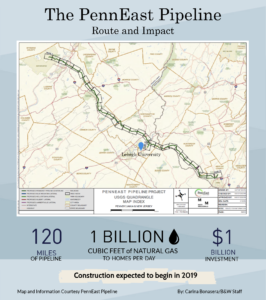 The PennEast Pipeline Company, LLC, a coalition of five energy companies, put forward a plan to construct a 120-mile natural gas transmission pipeline running underground from Luzerne County, Pennsylvania, to Mercer County, New Jersey.
The PennEast Pipeline Company, LLC, a coalition of five energy companies, put forward a plan to construct a 120-mile natural gas transmission pipeline running underground from Luzerne County, Pennsylvania, to Mercer County, New Jersey.
The line will carry about 1 billion cubic feet of natural gas to local homes daily, supplying the area with inexpensive, domestically-produced energy. The route would cut through Northampton County.
According to PennEast, the pipeline would have saved Pennsylvania and New Jersey residents about $435 million in energy costs if it had existed in the winter of 2017-18.
At first glance, the pipeline, which is scheduled for construction starting this year, appears to be a win-win for PennEast and local residents. However, some communities along the route have spoken out against its possible repercussions, including environmental damage, eminent domain issues and safety risks for people living near the line. Though branded as mutually beneficial, the PennEast Pipeline has proven to be a point of contention.
The five energy companies that make up PennEast are Enbridge, NJR Pipeline Company, SJI Midstream, Southern Company Gas and UGI Energy Services. The group seeks to provide a “low-cost, American-made energy source” by “leverage(ing) one of the country’s most prolific, affordable sources of natural gas,” said PennEast spokeswoman Pat Kornick.
The source of natural gas — Marcellus Shale — has the ability to affordably power homes, and the PennEast Pipeline is a way to bring that power to Pennsylvania and New Jersey residents.
Contrary to the jarring images of hulking machinery and flaming water faucets associated with natural gas in the media, the PennEast Pipeline would not directly contribute to the process of extraction — called hydraulic fracturing, or fracking. Rather, it will be a transmission pipeline — a way to transport natural gas between systems.
“Think of it in terms of a highway,” Kornick said. “A transmission pipeline is designed to get the natural gas from point A to point B.”
While this may come as a relief to residents, transmission pipelines still risk environmental damage during the construction period or in accidents when the line is active.
“The gas itself can escape and leak into the atmosphere,” said Dork Sahagian, an earth and environmental science professor. “And methane is about 85 times stronger (of a) greenhouse gas than (carbon dioxide). If you leak even one percent of the natural gas, that one percent is just about as much of a greenhouse global warming potential as the 99 percent that’s burned and turned into (carbon dioxide).”
Local environmental groups and residents use these concerns to fuel their fight against the pipeline.
Jacquelyn Bonomo, president and CEO of environmental advocacy group PennFuture, said that pipelines are associated with an increase in methane emissions as well as short term damage like disruption of land and habitat fragmentation. She also said that they put water systems at risk in the event of a leak or explosion.
In anticipation of these risks, PennEast has made efforts to reduce environmental damage and ensure that the pipeline is minimally invasive. Part of this involved a lengthy approval process with “checks and balances” to help ensure safety and compliance.
Kornick said the project was under review for more than three years, and multiple federal and state agencies were involved. PennEast ultimately received a Certificate of Public Convenience and Necessity from the Federal Energy Regulatory Commission, approving the project. During this process, more than 23 regulatory agencies provided input.
PennEast has communicated with the community to design a route that is minimally invasive. Kornick said more than 100 route options were considered to determine what the least-harmful and most efficient route would be.
Even with an optimized path, some residents face property disruption and other unpleasant results associated with the laying of the pipeline. Some residences fall within a “blast zone” — the radius at which damage would occur if a pipeline were to explode.
While an explosion is not a likely risk for the PennEast Pipeline, it is still possible.
Roy Christman, a member of the anti-pipeline group Save Carbon County, said the line will cut diagonally across a large chunk of his corn and soybean farm. In addition to disrupting farming procedures, it will put his house — which falls within the blast zone — at risk.
“We get to continue to farm on top of pipeline, but it’s only down three feet, and if you hit it with some kind of farm equipment, there’s always a chance it could blow,” he said. “It’s a really disturbing thing.”
Another neighborhood that was initially located about 200-300 feet from the pipeline — far within the 950-foot blast zone — negotiated with PennEast to move the line, according to John Gallagher, Bethlehem Township Third Ward Commissioner. However, even after distancing it from the houses, it was not far enough away to make residents feel at ease.
Gallagher said after further negotiations with PennEast, it is only willing to move the pipeline about 400 feet away from the community.
He said the community is against the pipeline not only because of the potential risk of an accident, but also because its proximity will likely devalue their properties.
“They’re concerned that should any of them want to sell their property, it’ll be devalued because of the location of the pipeline,” Gallagher said. “They much prefer that the pipeline not be built.”
Despite backlash, the project is moving forward. The anticipated 2019 construction process will take about five months, Kornick said. Whether it proves to be a giant step forward for energy, or a bigger step backward for the environment, remains to be seen.
“At the most fundamental level, pipelines, other infrastructure and the buildout of the natural gas industry in Pennsylvania is the absolute wrong pathway for a country, a state and a planet that needs to deal with climate change,” Bonomo said.





Comment policy
Comments posted to The Brown and White website are reviewed by a moderator before being approved. Incendiary speech or harassing language, including comments targeted at individuals, may be deemed unacceptable and not published. Spam and other soliciting will also be declined.
The Brown and White also reserves the right to not publish entirely anonymous comments.
4 Comments
Lest Lehigh University forget, Asa made the money to found Lehigh from shipping coal by barge and later rail from PA coalfields to NYC.
Energy is what makes modern conveniences and life possible. Let’s not deprive the middle class and poor of cleaner less expensive energy. Who doesn’t want middle class and poor to benefit from cleaner energy? Who land owners who don’t want to provide pipeline corridor easements for the benefit of the common good.
Lehigh students should support this project because they, like Asa, understand the importance of energy transportation and because they believe in fair access to cleaner low cost energy for all.
This country needs to learn to conserve energy, and the middle class is precisely who will be hit with the pass-through costs of these pipelines. The New Jersey Rate Council said exactly that in comments on the FERC docket review of this proposed pipeline. The only entities that will benefit from this pipeline are the shippers, who are selling the gas to themselves to claim massive mid-stream profits. Their shareholders may do well in the short term, but the middle class and the poor stand to gain precisely nothing from this. There are no gas shortages at present, and the gas companies have continuously boasted of their excellent supply and low costs since PennEast was announced.
And as for the landowners who don’t want to provide easements, there are hundreds and hundreds of them. Over 7,000 comments were put onto the FERC docket by those of us who have reviewed the project documents from the start and realized there is nothing of value to communities or landowners.
Want to help the middle class and the poor? Advocate for truly clean wind, solar and hydro power projects. That will create thousands of new jobs (as opposed to the approximately 16 permanent full-time positions as reported by PennEast) in start-up small companies and provide truly clean, renewable energy. The new technologies in solar power mean older buildings could be renovated with panels and windows that are actually solar collectors. Parking lots could be retro-fitted with solar collector canopies for dual use of existing space. There are loads of truly renewable options that could mean jobs and small businesses for this area, but only if we look forward toward renewables and not backward at the antiquated and dangerous fossil fuels.
As a registered intervenor on the Federal Energy Regulatory Commission (“FERC”) docket, and as someone who has attending FERC Scoping hearings, I would like to point out just a few of PennEast’s oft-repeated inaccuracies. This is a 36 inch diameter transmission line which would transmit gas at 1,420 pounds per square inch (“PSI”) – NOT a distribution line which typically delivers gas at well under 10 psi. Virtually nobody “local” to this project in New Jersey is getting gas directly from this line. And last we knew this gas is going to be interconnected in Mercer County onto the Algonquin pipeline for transmission up to New England either for their use or for export.
There is no “win” for the residents along the proposed pipeline. Our property values will go down, our farms would be bisected, our drinking water would be exposed to arsenic attenuation by virtue of the coating on the pipeline, our air quality would be negatively impacted by the release of excess gas and leaks, and families within a half mile of the thing would be in the “kill zone” if it exploded. There are lots and lots of natural gas disasters to illustrate the deaths that can occur when these pipelines malfunction.
Ms. Kornick’s suggestion that this project was reviewed by independent agencies is misleading. The company hired to assist FERC in the environmental review, Tetra Tech, is a member of the Marcellus Shale Coalition – which advocates for natural gas usage. Tetra Tech was also indicted for tampering with soil samples and lying about it to the US Navy on the Hunters Point project. FERC’s review of the nearly 7,000 scoping comments put on the docket deliberately omitted a key report that pointed out that PennEast was selling the gas to itself and refuted how that constituted “customers”. The New Jersey Rate Counsel, a consumer advocate, commented that this project would afford PennEast profits akin to their winning the lottery, and that the costs of this pipeline would be passed on to consumers. Public comments put on the docket to address the inaccuracies in the Draft Environmental Impact Statement were met with FERC’s unilateral, blanket determination that PennEast would comply with all applicable standards without truly addressing the issues raised.
PennEast is proposing to build this pipeline near an active quarry with daily blasting, to horizontal directional drill (HDD) under 3 rivers, to HDD under parking lots in a busy shopping mall, scale steep slopes and make hard angles (as prohibited by the National Environmental Protection Agency [“NEPA”] standards) and run it near schools, homes, churches and a hospital. They seek to place the pipeline on top of the Milford Bluffs, a pre-Cambrian rock formation perilously close to the Ramapo fault, and take property that we, the people, voted to have our tax dollars preserve as green spaces.
There are truly clean, renewable methods to power our world. This antiquated and dangerous gas pipeline technology doesn’t pass muster.
2019 construction? That’s not even in the universe of reasonable. PennEast has just begun its surveys to write its reports to file its applications with NJDEP and DRBC. NJDEP has said it will take a year from the date they apply to completely review the permit applications. And from the looks of their just filed route amendments in PA, where they are making crazy sharp and curved turns with an HDD bore under the Lowe’s shopping center on Freemansburg Avenue and Rt 33, AND are going right through the middle of a house on William Penn Hwy – all with the benefit of their new surveys – it’s going to be quite awhile yet before they even approach a competent route that will pass muster with the regulators.